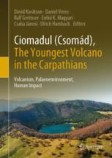Search
Search Results
-
Analysis of the 2020 Taal Volcano tephra fall deposits from crowdsourced information and field data
After 43 years of dormancy, Taal Volcano violently erupted in January 2020 forming a towering eruption plume. The fall deposits covered an area of...

-
Assessing volumes of tephra fallout deposits: a simplified method for data scarcity cases
A new method for assessing volumes of tephra deposits based on only two thickness data is presented. It is based on the assumptions of elliptical...

-
Historical explosive activity of Mount Melbourne Volcanic Field (Antarctica) revealed by englacial tephra deposits
Five tephra layers named BRH1 to 5 were sampled in an ice cliff located on the north-eastern flank of Mount Melbourne (northern Victoria Land,...

-
Laboratory tests to understand tephra sliding behaviour on roofs
Following explosive eruptions, loading from tephra fall deposits can lead to roof collapse. However, the load may be reduced significantly by tephra...

-
The late Pleistocene Sacarosa tephra-fall deposit, Misti Volcano, Arequipa, Peru: its magma, eruption, and implications for past and future activity
Between 38.5 ka cal BP and 32.4 ka cal BP, a dacitic Volcanic Explosivity Index 5 eruption at Misti volcano emplaced the Sacarosa tephra-fall...

-
Creating a digital database of tephra fallout distribution and frequency in Japan
Tephra fallout is a potential hazard to livelihoods, critical infrastructure, and health, even in areas that are far from volcanoes. Therefore, it is...

-
Tephra segregation profiles based on disdrometer observations and tephra dispersal modeling: Vulcanian eruptions of Sakurajima volcano, Japan
The profile of tephra concentration along a volcanic plume (i.e., the tephra segregation profile) is an important source parameter for the simulation...

-
How rainfall influences tephra fall loading — an experimental approach
The load a tephra fall deposit applies to an underlying surface is a key factor controlling its potential to damage a wide range of assets including...

-
Investigation of geomechanical properties of tephra relevant to roof loading for application in vulnerability analyses
Tephra fall can lead to significant additional loading on roofs. Understanding the relevant geomechanical properties of tephra is critical when...

-
Paleomagnetic evidence for episodic construction of the Mamiyadake tephra ring
Tephra rings that surround maar craters are typically inferred from field observations to have been emplaced rapidly over a time period of days to...

-
Magma storage and transport timescales for the 1959 Kīlauea Iki eruption and implications for diffusion chronometry studies using time-series samples versus tephra deposits
Complex crystal cargo in basaltic eruptions has the potential to yield diverse insights on pre- and syn-eruptive timescales of magma storage and...

-
Provenance of colorless and brown volcanic glass in late Pleistocene tephra layers in the Western Philippine Sea
Tephra layers in the western Philippine Sea, characterized by abundant volcanic glass shards, may provide crucial evidence on the eruption history of...
-
Tephra dispersal and composition reveal the explosive onset of a large basaltic fissure eruption: Timanfaya, Lanzarote, 1730–1736 CE
Basaltic fissure eruptions are chiefly characterized by sizable emissions of lava flows and volcanic gases, posing significant hazards. However, such...

-
Constraints on building susceptibility zone from tephra-lapilli loading through isopach map**: A case study of the Quaternary (<27.4 - >1.1 ka ), VEI 3–4 eruptions of Sumbing volcano, Central Java, Indonesia
This study documents the first record of seven-, Quaternary (<27.4 - >1.1 ka) lapilli fall layers at Sumbing volcano, Central Java, Indonesia. These...

-
Sulfur in the Tephra of the ca. 1500 BP Opala Eruption, Kamchatka
AbstractSulfur-containing ejecta of Plinian-type eruptions can be transported to great distances in gas pores of ash particles. The mean...

-
A quantitative assessment of crop vulnerability to tephra hazard at Tungurahua volcano, Ecuador: understanding the effect of volcanic and biological factors
Crops are regularly impacted by tephra from explosive volcanic eruptions, causing significant economic losses and jeopardising farmers’ livelihood at...

-
Two sources of uncertainty in estimating tephra volumes from isopachs: perspectives and quantification
Calculating the tephra volume is important for estimating eruption intensity and magnitude. Traditionally, tephra volumes are estimated by...

-
Understanding and modeling tephra transport: lessons learned from the 18 May 1980 eruption of Mount St. Helens
Discoveries made during the 18 May 1980 eruption of Mount St. Helens advanced our understanding of tephra transport and deposition in fundamental...

-
Gone with the Wind: Dispersal of Ciomadul Tephra
Ciomadul’s last explosive eruptions produced large volumes of pumice and ash, so-called tephra, which had the potential to be dispersed by wind over...
-
The spatiotemporal evolution of compound impacts from lava flow and tephra fallout on buildings: lessons from the 2021 Tajogaite eruption (La Palma, Spain)
The simultaneous or sequential occurrence of several hazards—be they of natural or anthropogenic sources—can interact to produce unexpected compound ...

